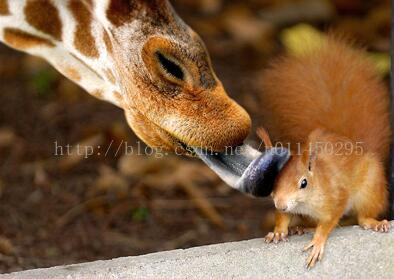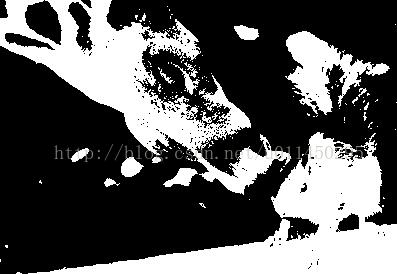这篇文章将为大家详细讲解有关C语言如何实现24位彩色图像二值化,小编觉得挺实用的,因此分享给大家做个参考,希望大家阅读完这篇文章后可以有所收获。
具体内容如下
// huiduhua.cpp : 定义控制台应用程序的入口点。
//
#include "stdafx.h"
#include<stdio.h>
#include<windows.h>
int _tmain(int argc, _TCHAR* argv[])
{
BITMAPFILEHEADER bfhead;
BITMAPINFOHEADER bihead;
RGBQUAD *pColorTable;
unsigned char *pBmpBuf;
FILE *fp1=fopen("鼠.bmp","rb");
if(fp1==0)
return 0;
fread(&bfhead,14,1,fp1); //将文件头读入内存
fread(&bihead,40,1,fp1); //将信息头读入内存
int LineByte=(bihead.biWidth*24/8+3)/4*4; //保证每行字节数为4的整数倍
pBmpBuf=new unsigned char[LineByte*bihead.biHeight]; //为数据区分配内存空间
fread(pBmpBuf,LineByte*bihead.biHeight,1,fp1); //将bmp数据区读入内存
fclose(fp1);
printf("Width:%d, Height: %d,biBitCount:%d\n",bihead.biWidth,bihead.biHeight,bihead.biBitCount);
//现将真彩图灰度化
int LineByte1=(bihead.biWidth*8/8+3)/4*4; //由于灰度化后每像素位数变为8,所以每行字节数发生改变,但仍要求为4的整数倍
FILE *fp2=fopen("鼠2.bmp","wb");
if(fp2==0)
return 0;
//更改文件头,并将其保存
bfhead.bfSize=14+40+sizeof(RGBQUAD)*256+LineByte1*bihead.biHeight; //更改文件大小
bfhead.bfOffBits=14+40+sizeof(RGBQUAD)*256; //更改偏移值
fwrite(&bfhead,14,1,fp2);
//更改信息头并将其保存
bihead.biBitCount=8; //更改每像素位数
bihead.biSizeImage=LineByte1*bihead.biHeight; //更改数据区大小
fwrite(&bihead,40,1,fp2);
//因为灰度化图像有颜色表,所以创建颜色表并保存
pColorTable=new RGBQUAD[256];
for(int i=0;i<256;i++)
pColorTable[i].rgbRed = pColorTable[i].rgbGreen = pColorTable[i].rgbBlue = i;//使颜色表中每种颜色的R,G,B分量相等且等于索引值
fwrite(pColorTable,sizeof(RGBQUAD),256,fp2);
//改变数据区
unsigned char *pBmpBuf1;
pBmpBuf1=new unsigned char[LineByte1*bihead.biHeight];
for(int i=0;i<bihead.biHeight;i++)
for(int j=0;j<bihead.biWidth;j++)
{
unsigned char *pb1,*pb2;
pb1=pBmpBuf+i*LineByte+j*3;
int y=*(pb1)*0.299+*(pb1+1)*0.587+*(pb1+2)*0.114;
pb2=pBmpBuf1+i*LineByte1+j;
*pb2=y;
}
//二值化方法一:阈值设为127,灰度值小于127的置零,其他的置为255;
//for(int i=0;i<bihead.biHeight;i++)
// for(int j=0;j<bihead.biWidth;j++)
// {
// unsigned char *pb;
// pb=pBmpBuf1+i*LineByte1+j;
// if(*pb<127) //将每个像素值与127比较
// *pb=0;
// else
// *pb=255;
// }
//方法二:计算像素的平均值K,扫描图像的每个像素值如像素值大于K像素值设为255(白色),值小于等于K像素值设为0(黑色)
int y=0;//像素和
int k=0;//像素个数
for(int i=0;i<bihead.biHeight;i++)
for(int j=0;j<bihead.biWidth;j++)
{
unsigned char *pb;
pb=pBmpBuf1+i*LineByte1+j;
y=y+*pb; //计算所有像素灰度值之和
k++; //统计像素个数
}
y=y/k; //求像素平均值
for(int i=0;i<bihead.biHeight;i++)
for(int j=0;j<bihead.biWidth;j++)
{
unsigned char *pb1;
pb1=pBmpBuf1+i*LineByte1+j;
if(*pb1<y) //将每个像素值与平均值作比较
*pb1=0;
else
*pb1=255;
}
fwrite(pBmpBuf1,LineByte1*bihead.biHeight,1,fp2);
fclose(fp2);
system("pause");
return 0;
}

关于“C语言如何实现24位彩色图像二值化”这篇文章就分享到这里了,希望以上内容可以对大家有一定的帮助,使各位可以学到更多知识,如果觉得文章不错,请把它分享出去让更多的人看到。
亿速云「云服务器」,即开即用、新一代英特尔至强铂金CPU、三副本存储NVMe SSD云盘,价格低至29元/月。点击查看>>
免责声明:本站发布的内容(图片、视频和文字)以原创、转载和分享为主,文章观点不代表本网站立场,如果涉及侵权请联系站长邮箱:is@yisu.com进行举报,并提供相关证据,一经查实,将立刻删除涉嫌侵权内容。